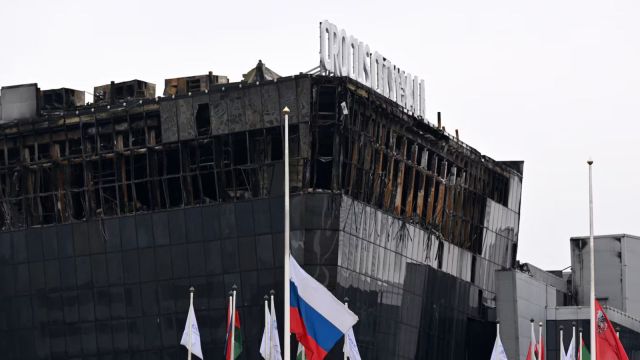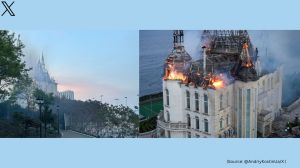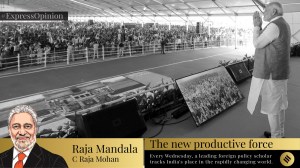- India
- International
An Islamic State terror group draws half its recruits from tiny Tajikistan
Tajik adherents of the Islamic State group — especially within its affiliate in Afghanistan known as the Islamic State Khorasan Province (ISKP), or ISIS-K — have taken increasingly high-profile roles in a string of recent terrorist attacks.
 Over the past year alone, Tajiks have been involved in assaults in Russia, Iran and Turkey, as well as foiled plots in Europe. ISIS-K is believed to have several thousand soldiers, with Tajiks constituting more than half, experts said. (file)
Over the past year alone, Tajiks have been involved in assaults in Russia, Iran and Turkey, as well as foiled plots in Europe. ISIS-K is believed to have several thousand soldiers, with Tajiks constituting more than half, experts said. (file)The mother of one of the suspects in the bloody attack on a concert hall near Moscow last month wept as she talked about her son. How, she wondered, did he go from the bumpy, dirt roads of their village in Tajikistan, in Central Asia, to sitting, bruised and battered, in a Russian courtroom accused of terrorism? Even though he spent five years in Tajik prisons as a teenager, she said he never exhibited signs of violent extremism.
“We need to understand — who is recruiting young Tajiks, why do they want to highlight us as a nation of terrorists?” said the mother, Muyassar Zargarova.
Many governments and terrorism experts are asking the same question.
Tajik adherents of the Islamic State group — especially within its affiliate in Afghanistan known as the Islamic State Khorasan Province (ISKP), or ISIS-K — have taken increasingly high-profile roles in a string of recent terrorist attacks.
Over the past year alone, Tajiks have been involved in assaults in Russia, Iran and Turkey, as well as foiled plots in Europe. ISIS-K is believed to have several thousand soldiers, with Tajiks constituting more than half, experts said.

“They have become key to ISKP’s externally focused campaign as it seeks to gain attention and more recruits,” said Edward Lemon, an international relations professor at Texas A&M University who specializes in Russia, Tajikistan and terrorism.
Analysts say a kind of double whammy leaves Tajiks vulnerable to recruitment. An increasingly authoritarian former Soviet republic, Tajikistan ranks among the world’s poorest countries, which fuels discontent and drives millions of migrant laborers to seek better lives abroad. In a country of 10 million people, a majority of working men, estimated at more than 2 million, seek employment abroad at any given time.
And most migrants end up in Russia, where rampant discrimination, low wages, poor prospects and isolation make some susceptible to jihadi recruiters. Officially, about 1.3 million Tajik laborers are in Russia, although experts believe hundreds of thousands of others work there illegally.
“The new Tajik generation has lost all belief in the future,” said Muhiddin Kabiri, the exiled leader of the country’s Islamic Renaissance Party, a moderate opposition group that was abruptly outlawed as “extremist” in 2015. “There are only two choices: a secular dictatorship, and as an alternative, the Islamic State or other radical Islamic groups.”
As many as 2,000 Tajiks flocked to the physical caliphate established by the Islamic State in parts of Syria and Iraq from 2014-19. With the caliphate dismantled but not eradicated — and with branches from Africa through the Middle East to Central Asia — ISIS-K has revived some of the would-be state’s global ambitions.
Recruitment of foot soldiers is focused online, where ISIS-K maintains an extensive media operation in Arabic, English, Russian and other languages. Russia is a frequent target. Many online testimonials from Tajiks imply that Muslim men who avoid fighting with the Islamic State are not really men.
Asfandyar Mir, a senior counterterrorism specialist at the U.S. Institute of Peace in Washington, highlighted the kind of video post intended to incite Tajik migrant workers in Russia. A commander who has since been killed, using the nom de guerre Furkan Falistini, speaks directly to laborers there: “When the Russian police see you on the streets, Tajiks hide their eyes, hoping the police do not see them,” he says in the video. “You should look at them so that they are scared of you. You start killing them, and God will remedy your fears.”
Days after Russia charged four migrant laborers from Tajikistan with the concert hall attack that killed 145 people, ISIS-K launched an online Tajik-language magazine, the Voice of Khorasan. Its rollout, days after the first Turkish edition, appeared to underscore the group’s widening aspirations, noted Lucas Webber, a researcher who tracks the Islamic State’s presence online.
While the magazine mentioned the Islamic State’s long-standing hostility toward Russia, the main story lambasted the 30-year, iron-fisted rule of Tajikistan’s President Emomali Rahmon.
“Rahmonov the Devil was the first to start eradicating Islam under the guise of being a Muslim,” the article said. The president changed his surname to the more Tajik-sounding Rahmon in 2007, but the Islamic State uses the old one, not least to highlight his close ties with Russian President Vladimir Putin.
After the Tajik suspects in the concert hall attack appeared in a Russian courtroom bearing wounds from an apparent torture, one online poster said, “Broadcasting videos of prisoners being tortured by you has increased the thirst of thousands of brothers for your blood.”
Another post showed what appeared to be a man in military fatigues staring at television screens that showed London, Paris, Rome and Madrid. “After Moscow … Who is the next?!” the English text read.
There is no single formula for radicalization, experts say, but for some young Tajik migrants, personal grievances outweigh geopolitical considerations.
Tajikistan’s problems are rooted in a vicious civil war that raged for five years, starting in 1992, after it won independence from the Soviet Union. Rahmon, the former head of a collective farm who became president in 1994, signed a peace agreement with the opposition that guaranteed representation.
Initially, some criticism of government corruption and nepotism was allowed, and the Islamic Renaissance Party held a couple of parliament seats. But when the party was declared a terrorist organization, opposition figures were killed, jailed or driven into exile. Tajikistan holds at least 1,000 political prisoners, according to Kabiri, the party’s exiled head.
Rahmon, 71, was born in the Soviet Union two days before Putin, and they share autocratic impulses. The Kremlin has long shored up Rahmon’s rule by stationing an estimated 7,000 troops in Tajikistan, a rare large deployment outside Russia.
The more the Islamic State ties Rahmon to Putin, “the more it looks like he is hitching his wagon to Russia, the less legitimate his regime seems and the more likely they are to increase their popularity among Tajiks,” said Steve Swerdlow, a professor of international relations at the University of Southern California and a veteran human rights researcher in Central Asia.
Rahmon pushed through a constitutional referendum in 2016 allowing him to remain president for life. News releases on the presidential website refer to him as “the Founder of Peace and National Unity.” His oldest son, Rustam Emomali, 36, chair of the National Assembly and the mayor of Dushanbe, the capital, is expected to succeed his father.
Rahmon wages a rigorous campaign against public signs of piety. People with beards or hijabs are subject to random harassment, with beards sometimes forcibly shaved in public or hijabs torn off. A powerful Committee on Religion, Regulation of Traditions, Celebrations and Ceremonies oversees every facet of worship, including building mosques and printing books.
“They have this very tight control over official Islam, and anything that exists beyond that is deemed extremist, dangerous,” said Lemon, the professor at Texas A&M.
Given the violence fomented by jihadis globally, Tajikistan’s government has reasons for concern, Swerdlow noted. But harsh measures can feed the very extremism that they are intended to curtail.
Echoing Soviet positions, Rahmon blames extremism solely on outside influences. In a speech last month, he said Tajiks enjoyed freedom of religion, while radical ideas originated from “dubious” religious schools abroad or foreign intelligence services.
“These actions were plotted by malicious groups and special services of some countries, and they take advantage of the lack of education, inexperience and ignorance of some of our youth,” the president said. More than 1,000 Tajik militants had died in foreign armed conflicts, he said, with thousands more missing.
In terms of religious freedom, the United States has repeatedly designated Tajikistan a “country of particular concern.” Officials at the Defense and State Departments declined requests for interviews about extremism linked to Tajikistan.
The State Department issued a brief statement saying it worked with Tajikistan and other Central Asian countries to strengthen law enforcement and degrade terrorist groups. One former senior Tajik police officer, trained in counterextremism in the United States, famously became the overall military commander for the Islamic State group’s caliphate around 2016 before he died.
After the terrorist attack outside Moscow, Russia inaugurated sweeping expulsions.
In Tajikistan, the mothers of three suspects listed the problems their sons typically faced in Russia: Salaries too low to pay rent or to afford the permits needed to drive a taxi, for example.
“Let them answer who bought the weapons, who gave them their equipment,” Zargarova said. “My son didn’t have money for a gun.”
May 01: Latest News
- 01
- 02
- 03
- 04
- 05






























